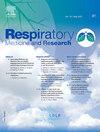法国支气管扩张:来自欧洲支气管扩张登记(EMBARC) 630例患者的疾病特征数据
IF 1.8
4区 医学
Q3 RESPIRATORY SYSTEM
引用次数: 0
摘要
背景:在法国,人们对成人支气管扩张的特点知之甚少。方法采用一项描述性横断面研究,对18个参与研究的中心中诊断为呼吸道症状和CT扫描结果相结合的具有临床意义的支气管扩张的成人(≥18岁)的特征进行描述。收集了病因学、肺功能、症状、微生物学、治疗和生活质量等方面的数据。结果2016年1月至2022年7月共纳入成人630人(女性66%,55岁以上73.8%)。特发性病因和感染后病因分别占33.0%和37.1%;COPD和哮喘分别在15.6%和23.6%的受试者中存在,分别只有3.8%和2.9%的受试者被认为是支气管扩张的原因。只有25%的肺活量正常,7.3%需要长期氧疗。78.1%的患者存在每日咳痰,29.0%的患者经修订的医学研究委员会(mMRC)呼吸困难评分≥2。痰液标本细菌培养阳性率为77.8% (n = 455);其中157例(34.5%)在过去一年感染铜绿假单胞菌。在研究开始前的一年中,75.4%的患者报告至少一次呼吸恶化,33.8%的患者至少住院一次,24.5%的患者接受门诊肠外抗菌药物治疗(OPAT)。支气管扩张严重程度指数分别为26.0%、36.4%、37.6%为轻、中、重度。结论在法国,成人支气管扩张患者有显著的疾病负担。呼吸恶化是医疗保健利用的原因,其预防可能需要专门的多学科护理和开发新的治疗干预措施。本文章由计算机程序翻译,如有差异,请以英文原文为准。
Bronchiectasis in France: data on disease characteristics in 630 patients from the European Bronchiectasis registry (EMBARC)
Background
Little is known about the characteristics of adults with bronchiectasis in France.
Methods
A descriptive cross-sectional study was conducted to describe the characteristics of adults (≥18 years) with clinically-significant bronchiectasis, diagnosed on a combination of respiratory symptoms and CT scan findings, and followed in 18 participating centers. Data on, etiology, lung function, symptoms, microbiology, treatments and quality of life were collected.
Results
Between January 2016 and July 2022, 630 adults (females: 66 %; ≥55 years: 73.8 %) were included. Idiopathic and post-infective causes represented 33.0 % and 37.1 % respectively; COPD and asthma, which were present in 15.6 % and 23.6 % of subjects, were considered as causes of bronchiectasis in only 3.8 % and 2.9 %, respectively. Only 25 % had normal spirometry and 7.3 % required long-term oxygen therapy. Daily sputum production was present in 78.1 % and 29.0 % had a modified Medical Research Council (mMRC) dyspnea score ≥2. Positive bacterial sputum culture was found in 77.8 % of those with sputum samples (n = 455); including 157 (34.5 %) positive for Pseudomonas aeruginosa within the past year. During the year prior to study entry, 75.4 % of patients reported at least one respiratory exacerbation, 33.8 % had at least one hospitalization and 24.5 % received outpatient parenteral antimicrobial therapy (OPAT). Using the bronchiectasis severity index 26.0 %, 36.4 % and 37.6 % were considered as having mild, moderate and severe disease, respectively.
Conclusion
In France, adults with bronchiectasis experience significant disease burden. Respiratory exacerbations are responsible for healthcare utilization and their prevention may require specialized multidisciplinary care and the development of novel therapeutic interventions.
求助全文
通过发布文献求助,成功后即可免费获取论文全文。
去求助
来源期刊

Respiratory Medicine and Research
RESPIRATORY SYSTEM-
CiteScore
2.70
自引率
0.00%
发文量
82
审稿时长
50 days
 求助内容:
求助内容: 应助结果提醒方式:
应助结果提醒方式:


